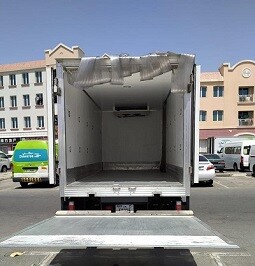
The Critical Role of Chiller Trucks with Tail Lifts in Modern Logistics
In the dynamic world of logistics, the transport of perishable items demands innovation. Chiller trucks with tail lifts have become pivotal. These vehicles ensure goods stay fresh and reach their destinations safely. Let’s explore their benefits and how Drive Cool Transport is leading the way.
Essential for Perishable Goods
Keeps Items Fresh
Chiller trucks maintain temperatures. This is crucial for food, flowers, and pharmaceuticals. It prevents spoilage.
Tail Lifts Enhance Safety
Tail lifts make loading safer and easier. They reduce injury risks and protect goods from damage.
Streamlines Operations
Efficient Loading
Tail lifts speed up the loading process. This efficiency is vital for maintaining the cold chain.
Versatile Use
These trucks serve many industries. They are essential for food delivery, pharmaceuticals, and more.
Reduces Costs
Less Product Loss
Temperature control and safe loading mean fewer damaged goods. This saves money.
Saves on Labor
Tail lifts mean less manual work. This cuts labor costs.
Ensures Safety and Compliance
Safer for Workers
Tail lifts reduce the risk of lifting injuries. This keeps operations compliant with safety standards.
Meets Health Standards
For industries with strict regulations, these trucks ensure compliance. They keep perishable goods in optimal condition.
Drive Cool Transport: Your Partner in Logistics
Drive Cool Transport stands out in offering chiller trucks with tail lifts. We understand the logistics challenges businesses face. Our fleet is designed to meet these needs.
Tailored Logistics Solutions
We offer solutions that match your specific requirements. Whether it’s a single delivery or a full logistics strategy, we’re here to help.
Quality and Reliability
Our trucks are well-maintained and equipped with the latest technology. This guarantees reliability and the safe transport of your goods.
Expert Handling
Our team is trained in handling perishables. We ensure your items arrive in perfect condition.
Conclusion
Chiller trucks with tail lifts are revolutionizing logistics. They ensure the safe, efficient transport of perishable goods. Drive Cool Transport is at the forefront, providing reliable, high-quality services. Our commitment to innovation and customer satisfaction makes us the ideal logistics partner.
